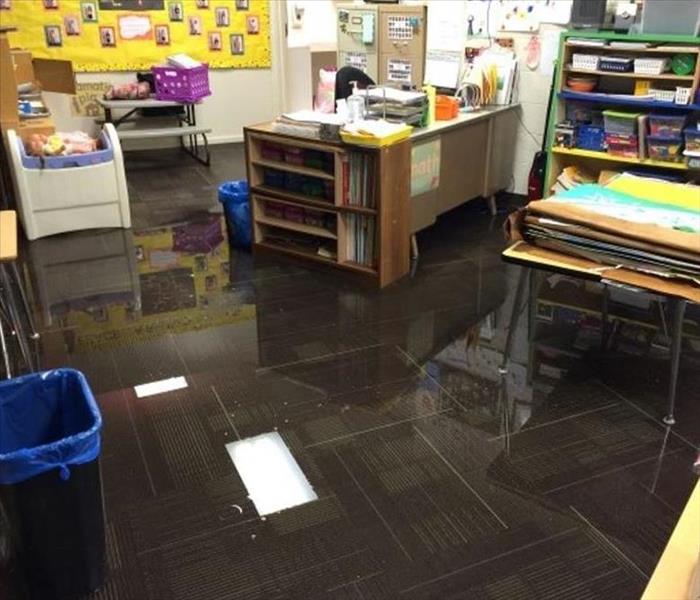Recent Posts
Thanksgiving Fire Safety Tips
11/22/2024 (Permalink)
Most families cook on Thanksgiving or know someone that will be cooking dinner. According to The National Fire Prevention Association (NFPA) Thanksgiving is the peak day for cooking fires while Christmas Day and Christmas Eve ranked second and third.
NFPA listed the following stats:
- Unattended cooking was the leading contributing factor in cooking fires and fire deaths.
- On Thanksgiving day alone, an estimated 1,610 home cooking fires were reported to U.S fire departments in 2022, reflecting a 399 percent increase over the daily average.
- Turkey fryers that use cooking oil are not safe. These fryers use large amounts of oil at high temperatures, which can cause devastating burns.
Now would be a great time to make sure all your smoke alarms are working in your home. It is also recommended that you remain in the home while cooking and check on the turkey often.
Source: NFPA Research
Spring Rain and Flooding: Be Prepared with SERVPRO
5/13/2024 (Permalink)
 SERVPRO taking on a flood
SERVPRO taking on a flood
As spring approaches, so does the unpredictable weather. Spring rain can quickly escalate into flooding, causing significant damage to homes and businesses. At SERVPRO®, we understand the urgency of disaster readiness. Let’s explore why preparation matters and how SERVPRO can help.
- The Spring Flood Season
- Common Threat: According to the Federal Emergency Management Agency (FEMA), flooding is the most frequent natural disaster in the U.S.
- Late Spring Flash Floods: Late spring and summer are notorious for flash floods. These sudden, intense floods can catch anyone off guard.
- Why Prepare?
- Advance Planning: SERVPRO urges property owners to prepare now. Waiting until disaster strikes is risky.
- Emergency Kit: Create an emergency kit with essentials like water, non-perishable food, flashlights, and first aid supplies.
- FEMA Checklist: Use FEMA’s emergency preparedness checklist to cover all bases.
- SERVPRO’s Role
- Disaster Response Experts: SERVPRO specializes in disaster cleaning, restoration, and construction services.
- Swift Action: When flooding occurs, our professionals swiftly assess the situation and extract water using advanced equipment.
- Restoring Normalcy: Our goal is to make it “Like it never even happened.”
Spring rain may bring flooding, but with SERVPRO by your side, you’re not alone. Prepare now, stay safe, and remember that SERVPRO is here to help when you need it most.
Rise Above the Waters: Safeguarding Your Treasures
5/13/2024 (Permalink)
 Flood occurring in storage room where contents on the bottom are damaged and elevated contents remain safe and unaffected.
Flood occurring in storage room where contents on the bottom are damaged and elevated contents remain safe and unaffected.
When it comes to protecting your belongings during a basement flood, elevating items off the floor is crucial. Here’s why:
Risk Reduction: Since water accumulates at the lowest point first, any items stored on the floor are at high risk of getting damaged. Elevating belongings on shelves or supports helps minimize the risk of water exposure.
Health and Safety: Flooding can introduce hazardous materials, including raw sewage and chemical contaminants. Keeping items off the floor reduces the chances of direct contact with these substances during cleanup.
If you must store items on the floor, consider using water-tight containers. These can help protect your possessions from water damage even if flooding occurs.
Remember, relocating items to upper levels or a safe storage area ensures your cherished possessions remain protected against basement water damage, reducing potential losses. If you or someone you know experiences unexpected water in your home, we here at SERVPRO® are always here to help!
Its Beginning To Look A Lot Like Christmas
11/21/2023 (Permalink)
 Following a few simple safety tips can ensure you and your family enjoy a safe holiday season.
Following a few simple safety tips can ensure you and your family enjoy a safe holiday season.
We all love decorating for the holidays however it is imperative that you follow a few safety tips to ensure a safe holiday season.
The National Fire Protection Association (NFPA) reported 13 million dollars in property damage from Christmas trees. In the event that your family buys a live tree, keep in mind that trees dry out over time, electrical lights malfunction and poorly located heating sources can make for a hazardous combination. Below are few suggested safety tips from the NFPA:
- Fresh trees are less likely to catch fire, so look for a tree with vibrant green needles that are hard to pluck and don’t break easily from its branches.
- Always place your tree away from heat sources like fireplaces, radiators, candles, heat vents or lights, and keep the tree base filled with water to avoid drying out.
- Make sure all your indoor and outdoor Christmas lights have been tested in a lab by the UL or ETL/ITSNA for safety, and throw out any damaged lights. If you have pets make sure you check the cords and lights daily for any damage they may have caused by playing with the decorations.
- Any lights you use outdoors must be labeled suitable for exterior placement, and be sure to plug them into a ground-fault circuit interrupter protected receptacle.
- Keep all your holiday candles away from your Christmas tree, surrounding furniture and décor.
- Bedtime means lights off. DO NOT FORGET to turn your Christmas tree lights off each night.
When your tree begins to drop its needles, it’s time to say goodbye to your evergreen foliage until next year.
BE READY
11/20/2023 (Permalink)
St Clair County Homeland Security and Emergency Management recommend residents and local businesses check out their website and learn how to prepare for an emergency. Our County only has 800 emergency responders for 170,000 residents. We know that during the first 72 hours following an emergency or disaster, essential services may not be available. Businesses and residents must BE READY to survive on their own after an emergency. This means having your own food, water, and other supplies to last for at least three days. It is recommended that every family and business create an EMERGENCY SUPPLY KIT. This kit will contain the items you need to survive prior to help arriving. For more helpful advice you can also check out SERVPRO of Marine City/Romeo website or contact our office. We are always here to help.
Thanksgiving Fire Safety
11/20/2023 (Permalink)
 Follow a few smart tips and you can cook beautiful holiday meals safely.
Follow a few smart tips and you can cook beautiful holiday meals safely.
Did you know that there are more home cooking fires on Thanksgiving Day than any other day of the year? Fire safety must be a priority in the kitchen year round not just during the holidays. The National Fire Prevention Association offers the following tips:
- Stay in the kitchen when you are cooking on the stove top so you can keep an eye on the food.
- Stay in the home when cooking your turkey, and check on it frequently.
- Keep children away from the stove. The stove will be hot and kids should stay three feet away.
- Make sure kids stay away from hot food and liquids. The steam or splash from vegetables, gravy or coffee could cause serious burns.
- Keep knives out of the reach of children.
- Be sure electric cords from an electric knife, coffee maker, plate warmer or mixer are not dangling off the counter within easy reach of a child.
- Keep matches and utility lighters out of the reach of children — up high in a locked cabinet.
- Never leave children alone in room with a lit candle.
- Keep the floor clear so you don’t trip over kids, toys, pocketbooks or bags.
- Make sure your smoke alarms are working. Test them by pushing the test button.
For additional fire safety information you can also check out our website or contact our SERVPRO office at (586) 336-7373 24 hours a day.
Pipe Burst Problems and Prevention
12/22/2022 (Permalink)
 Pipe burst in Peace School
Pipe burst in Peace School
With winter finally here, and the snow and cold due to come, the most optimal time for pipe bursts comes along with it. The cold winter months are responsible for thousands of pipe bursts yearly, with the potential of more than 5,000 dollars in damage as a result. We at SERVPRO of Marine City / Romeo know this situation too well, as it is responsible for many of the floods we see during the winter months. These situations usually arise when pipes are not insulated well enough and when the temperature gets very low, causing the water inside to freeze. When water freezes, it expands, increasing the pressure in the pipe and causing it to burst, letting out freezing cold water and damaging all surrounding structures. An example of this is shown in the attached image, where a pipe burst in a classroom, flooding and damaging the room and its contents. With this happening so often, we at SERVPRO of Marine City / Romeo have some important safety tips that can help prevent a disaster like this from occurring.
- First off, make sure your pipes are insulated, as without insulation, the pipes are very likely to freeze. One dollar a foot for insulation is way better than 5,000 dollars in damage.
- Secondly, keep your home heated and at a constant temperature, preferably at least 55°F, to help prevent pipes from freezing. While you may be paying more for your heating bill. It definitely beats the cost of cleaning up the mess from a burst pipe.
- Lastly, if needed, leave a sink slow dripping to allow water movement in the pipes. This helps prevent water from freezing as moving water has connecting energy, which is transferred into heat energy from friction in the pipe.
Overall, with the wave of cold months arriving, make sure to stay safe and warm, and while you're at it, keep those pipes warm too. If all else fails, a hairdryer on the pipes may do the trick. In the event that a pipe does burst, make sure to give us a call at (586)336-7373. We at SERVPRO are available 24/7 and faster to any-size disaster. We will make your cold crisis seem “Like it never even happened.”
Getting the Office Ready for Winter Storms
11/4/2022 (Permalink)
When the weather forecast predicts a serious winter storm, keep these preparation tips in mind for your small business:
- Communicate with your employees: Have a predetermined way to communicate with all employees to let them know if the store or office will be open that day.
- Let customers know if and when you’re closing: If you will be closing early due to a blizzard, or not opening at all, use social media channels to relay that information. If you have a store-front, make sure to post a sign notifying your customers of your closing as well.
- Salt the sidewalks: If you plan for your small business to be open during the winter storm, be sure to brine or salt the sidewalks to prevent ice from forming and causing slippery situations.
- Keep an eye on power lines: If you see a downed power line near your business, call 911 immediately and do not go near it, it could still live with electricity. Try to prevent any customers from getting near it as well.
- Consider buying a generator: Have a generator for any important devices or products needing electricity, like walk-in coolers and food storage.
- Check on your smoke and carbon monoxide detectors: Regularly replacing batteries for smoke and carbon monoxide detectors is a good practice, and especially important if you will be using a generator. Tip: if you’re using a portable generator, never keep it indoors. They produce high levels of carbon monoxide and could cause harm to those inside.
- Have mailing back-up plans: Think about what things you rely on the mail service to provide. If you have payroll checks or other important documents coming in the mail, and the roads are too bad for mail to be transported, do you have other ways of accessing them? Contact whoever is sending your important documents to ensure that mail interruptions will not cause disaster in your small business.
Winter Emergency Kit for a Small Business
In extreme cases of winter storms, you and your employees may become snowed in at work, or need to wait out the storm. In areas where heavy snowfall is typical, consider making a winter emergency kit for your small business to ensure winter workplace safety. These items, provided by FEMA include:
- A hand-crank or battery-charged radio
- Water and food snacks
- A whistle or noisemaker that can be used to signal for help
- Copies of important business documents, all kept in a waterproof and fireproof container.
- Flashlights and/or candles First-aid kit Moist towelettes or hand sanitizer
- Extra toiletries (including feminine hygiene products)
- Cell phone chargers for all types of cellular devices (and/or portable cell phone power banks or chargers)
Keeping an Eye Out for Frozen Pipes
11/4/2022 (Permalink)
Water has a unique property in it that expands as it freezes. This expansion puts tremendous pressure on whatever is containing it, including metal or plastic pipes. No matter the strength of a container, expanding water can cause pipes to break.
Pipes that freeze most frequently are:
- Pipes that are exposed to severe cold, like outdoor hose bibs, swimming pool supply lines, and water sprinkler lines.
- Water supply pipes in unheated interior areas like basements and crawl spaces, attics, garages, or kitchen cabinets.
- Pipes that run against exterior walls that have little or no insulation.
Protecting Pipes from Freezing
Before the onset of cold weather, protect your pipes from freezing by following these recommendations:
- Drain water from the swimming pool and water sprinkler supply lines following manufacturer's or installer's directions. Do not put antifreeze in these lines unless directed. Antifreeze is environmentally harmful, and is dangerous to humans, pets, wildlife, and landscaping.
- Remove, drain, and store hoses used outdoors. Close inside valves supplying outdoor hose bibs. Open the outside hose bibs to allow water to drain. Keep the outside valve open so that any water remaining in the pipe can expand without causing the pipe to break.
- Add insulation to attics, basements and crawl spaces. Insulation will maintain higher temperatures in these areas.
- Check around the home for other areas where water supply lines are located in unheated areas. Look in the garage, and under kitchen and bathroom cabinets. Both hot and cold water pipes in these areas should be insulated.
- Consider installing specific products made to insulate water pipes like a "pipe sleeve" or installing UL-listed "heat tape," "heat cable," or similar materials on exposed water pipes. Newspaper can provide some degree of insulation and protection to exposed pipes – even ¼” of newspaper can provide significant protection in areas that usually do not have frequent or prolonged temperatures below freezing.
- Consider relocating exposed pipes to provide increased protection from freezing.
Preventing Frozen Pipes
- Keep garage doors closed if there are water supply lines in the garage.
- Open kitchen and bathroom cabinet doors to allow warmer air to circulate around the plumbing. Be sure to move any harmful cleaners and household chemicals up out of the reach of children.
- When the weather is very cold outside, let the cold water drip from the faucet served by exposed pipes. Running water through the pipe - even at a trickle - helps prevent pipes from freezing.
- Keep the thermostat set to the same temperature both during the day and at night. By temporarily suspending the use of lower nighttime temperatures, you may incur a higher heating bill, but you can prevent a much more costly repair job if pipes freeze and burst.
- If you will be going away during cold weather, leave the heat on in your home, set to a temperature no lower than 55° F.
Thawing Frozen Pipes
- If you turn on a faucet and only a trickle comes out, suspect a frozen pipe. Likely places for frozen pipes include against exterior walls or where your water service enters your home through the foundation.
- Keep the faucet open. As you treat the frozen pipe and the frozen area begins to melt, water will begin to flow through the frozen area. Running water through the pipe will help melt ice in the pipe.
- Apply heat to the section of pipe using an electric heating pad wrapped around the pipe, an electric hair dryer, a portable space heater (kept away from flammable materials), or by wrapping pipes with towels soaked in hot water. Do not use a blowtorch, kerosene or propane heater, charcoal stove, or other open flame device.
- Apply heat until full water pressure is restored. If you are unable to locate the frozen area, if the frozen area is not accessible, or if you cannot thaw the pipe, call a licensed plumber.
- Check all other faucets in your home to find out if you have additional frozen pipes. If one pipe freezes, others may freeze, too.
All About Fire Damage Restoration
11/4/2022 (Permalink)
After the fire trucks leave, your home likely suffers from fire and smoke damage and extensive water damage from firefighting efforts. SERVPRO Franchise Professionals have the specialized fire restoration training needed to restore your home to pre-fire condition.
Have Questions About Fire, Smoke, or Soot Damage?
Call Today: (586) 336-7373
Every fire damage event is a little different, and requires a unique solution, but the general process stays the same. The steps listed below illustrate our process for the “typical” fire damage emergency.
Step 1: Emergency Contact
The restoration process begins when you call the SERVPRO Customer Care Center, which is staffed 24 hours a day. Our specialist will ask a series of questions regarding the fire damage event that will help us dispatch the nearest SERVPRO Franchise Professional with the appropriate equipment and resources.
Step 2: Inspection and Fire Damage Assessment
Our Professionals will carefully inspect and test adjoining rooms of your property to determine the extent of the fire, smoke, and soot damage. This step is crucial to developing a plan of action.
Step 3: Immediate Board-Up and Roof-Tarp Service
Fire damage can often compromise windows, walls, and roofs. To maintain security and to protect against further damage, the SERVPRO Franchise Professional can board up missing windows and walls and place tarps on damaged roofs.
Step 4: Water Removal and Drying (if water damage is present)
The water removal process begins almost immediately and removes the majority of the water. They will then use dehumidifiers and air movers to remove the remaining water and complete the drying process.
Step 5: Removal of Smoke and Soot from All Surfaces
The SERVPRO Franchise Professionals use specialized equipment and techniques to remove smoke and soot from ceilings, walls, and other surfaces.
Step 6: Cleaning and Sanitizing
They will clean all of the restorable items and structures that were damaged by the fire. They use a variety of cleaning techniques to restore your belongings to pre-fire condition. They’re also trained to remove odors using industrial air scrubbers and fogging equipment.
Step 7: Restoration
Restoration is the final step—getting your home or business to its pre-fire condition. Restoration may involve minor repairs, such as replacing drywall, painting, and installing new carpet; or it may entail major repairs such as the reconstruction of various areas or rooms in a home or business.





 24/7 Emergency Service
24/7 Emergency Service



